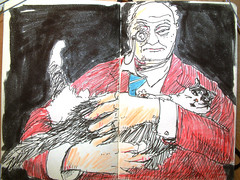
Patrick Moore‘s death should surely be marked globally, because it is the passing of a man who as an amateur had a greater impact in his field – specifically planetary astronomy – than many professionals. Are there any others left in pure science who can claim that?
Patrick Moore is most likely to be remembered in Britain as an eccentric populariser of astronomy, and as the presenter of the world’s longest running television programme, the monthly “The Sky at Night”. And he certainly achieved greatness as a populariser.
But his contributions to science should not be forgotten. His earlier claim to be the discoverer of Mare Orientale was mistaken – as Moore himself appeared to recognise later in life – but his contribution to the mapping and understanding of the Moon in the pre-space flight age was a real one. Indeed NASA are reported to have used his charts.
Anyone who has ever viewed the Moon through a telescope will understand the fascination for astronomers – especially in the days before space travel. It is surely the most beautiful thing that can be seen except for Earth from the the air or space itself. My only photos from this summer don’t really do it justice, but the deep valleys and wide basalt plains are still enticing.
Many of Moore’s ideas on the Moon – such as the idea that the craters were the result of vulcanism (discussed at length in V. A. Firsoff’s 1969 classic The Old Moon And The New) have now been decisively refuted by the scientific results of the Apollo programme, but they retained their credibility even after Neil Armstrong‘s giant leap because they were based on serious observation and thought (I saw Moore defend them as late as 1979 even though by then he was isolated in his view).
Moore was a prolific writer and while many recent works bearing his name appear to be attempts to cash-in on his recognition (for which we should bear him no ill-will), books such as Guide to the Planetsrepresented the pinnacle of accessible writing at the very moment long-range space travel was to transform our view of the Solar System permanently. (This has been subsequently been republished as New Guide to the Planets
which, presumably, includes much of the new information that came from the Voyager and other probes.
His death is a sad moment.
- I met Moore several times in 1979 when John Shutler, Finchley Catholic High School‘s legend of the physics lab, took a small group of us to several lectures he delivered at Queen Mary College at Mile End. Moore was charm himself and on our second meeting gave each of us a copy of his map of the Moon – then the amateur’s standard chart – and delivered some brilliant lectures. Mr Shutler’s embarrassment on having greasy hands (we’d all just been eating chips) at the first meeting was a source of much amusement, but did not trouble Moore.
Related articles
- Sir Patrick Moore dies aged 89 (telegraph.co.uk)
2 responses to “Death of Sir Patrick Moore”
Thank you for this lovely post in his memory. I will re-blog it if that’s ok? Patrick Moore was one of those people we always thought would be there forever.
Reblogged this on Day One and commented:
I love the illustration of Patrick Moore in this obituary, portrays him perfectly, the man we all believed would always be there, with his monacle & his telescope. We are all stardust, he is now with them